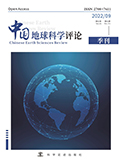

拉萨盆地为拉萨-日多弧间盆地的重要组成部分, 盆地内第四系较为发育且成因类型众多。分析该盆地内第四系物质组成、沉积特征及沉积环境等, 对研究青藏高原的演化历史具有重要意义。区内第四系主要为上更新统-全新统地层, 上更新统为冰碛沉积, 全新统为冲积、洪冲积、洪积、沼泽堆积及河床、河漫滩、河心滩沉积和风成砂堆积; 沉积相主要有冲积相、洪积相、风积相和冰碛相几个大类。通过野外实测地质剖面并结合前人钻孔资料分析, 对该区第四系进行研究, 初步建立了它们各自的沉积序列及相对新老关系。盆地内不同成因沉积物除了受区域构造运动影响外, 与区域内第四纪气候变化过程关系也非常密切, 特别是晚第四纪, 不管是河流冲积物还是高山冰 碛物的演化都与区域气候波动过程紧密相关。
The Lhasa Basin is an important component part of the Lhasa-Rhido Interarc Basin, in which the Quaternary System is relatively developed and has many types of genesis. It is important to analyze the composition of the Quaternary, sedimentary characteristics and depositional environment in the basin to study the evolution of the Tibetan Plateau. The Quaternary in the area is mainly composed of the upper Pleistocene-Holocene, the upper Pleistocene for the moraine deposition, Holocene is mainly alluvial, flood alluvial, flood, swamp accumulation and modern riverbed, river floodplain, river beach sedimentation and wind sand accumulation; sedimentary phase mainly alluvial phase, flood phase, wind and moraine phase of several major categories. Through the field measurement of geological profiles and combined with the analysis of the former borehole data, the Quaternary stratigraphy in the area is divided and compared, and their respective depositional sequences and the relative relationship between the old and the new have been initially established. In addition to the influence of regional tectonic movement, the sediments of different genesis in the basin are also very closely related to the Quaternary climate change process in the region, especially during the Late Quaternary period, no matter it is the river alluvial deposits or alpine moraines, the evolution is closely related to the regional climate fluctuation process.